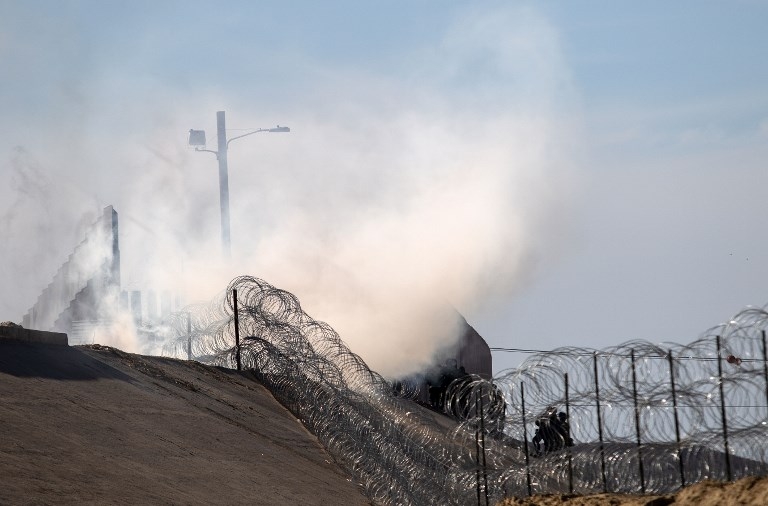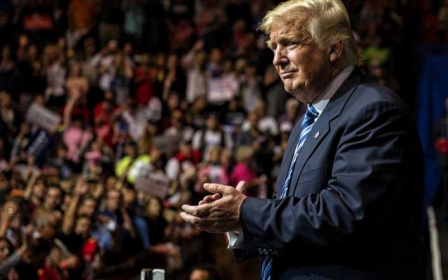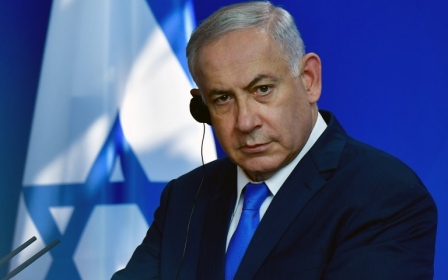The American right has its very own Gaza at the Mexico border

The scenes broadcast from the US-Mexico border on Sunday were typically depressing. Facing a protest by migrants from Central America, US border agents fired tear gas into a crowd that included children.
A few days earlier, an agent in Arizona was acquitted on charges of involuntary manslaughter after he fired his service weapon through the border fence, killing a 16-year old boy.
The response from US President Donald Trump, his administration and his allies in the media has been characterised by the kind of wounded, evidence-free fury we’ve come to expect. It has also revealed, again, a parallel between the American right wing and its counterpart in Israel.
For a supremacist culture that exists in the US and is being powerfully incarnated by Trump, the humanity of others and their needs cannot be faced and dissent of any kind is met with fury
From the outset, the reaction to the use of tear gas by American agents – which Mexico has called to be investigated – from those who would defend it, has focused on a couple of details that anyone familiar with the way Benjamin Netanyahu’s administration deals with its own violence at the Gaza border fence will be familiar with.
Namely, that rocks were being thrown and that children were being used as human shields. There is no evidence for the latter claim and the testimony of migrants, along with video footage, suggests that rocks were only thrown in response to the tear gas attacks, which caused a number of people to faint.
Those administering the violence were quick to claim that it was they who were actually the victims in the whole situation.
Homeland Security Secretary Kirstjen Nielsen accused the migrant organisers of the so-called “caravan” of using women and children as “human shields”, “putting vulnerable people in harm’s way”.
Rodney Scott, the chief border patrol agent for the San Diego sector, repeated the claims. "I kind of challenge that it was a peaceful protest, or that the majority of these people were claiming asylum," he told CNN. "If they were truly asylum seekers they would've just walked up with their hands up and surrendered, but that did not take place."
Israel playbook
Donald Trump suggested that some of the people at the border were not really parents, but “grabbers” who had taken children with them in order to improve their chances of asylum. He had no evidence for this claim. On Twitter, he wrote that many of the migrants are “stone cold criminals” and called on Congress to fund his long-touted “wall”.
The claim of victimhood on display here was straight out of the Israeli playbook.
These were not desperate people gathered by an imposing fence pleading to be treated with some kind of humanity, they were rock-throwing militants prepared to use their own children as shields. The border agents or soldiers firing at these people were not representatives of a hugely wealthy and overwhelmingly powerful military, they were imperilled patriots striving to uphold the rule of law and protect their nation’s freedom and independence.
This hysterical overstating of harm and denial of the humanity of the real victims in the situation – Central American migrants; Palestinians in Gaza – is both an almost unconscious response and a tool of the powerful.
At home in the United States, the treatment visited on young black men, who are forever being shot by the police for doing nothing other than terrifying and enraging officers by going about their daily business, is a stark example of the paranoia of power and the way in which it is shaped over decades and even centuries of oppression.
Mexico to Gaza
The connection between the policies and the priorities of the powerful and the plight of those demonised by the powerful is also obscured.
Migrants are very often fleeing violence and poverty and they believe that in the United States they will have opportunities they do not have at home. Global capitalism feeds on their home nations and then sells them a dream, one that can only be realised in the glittering citadels of the West.
The extreme domestic situation faced by many people in Central America - as in the Middle East - is directly connected to the military and economic priorities of the United States
The extreme domestic situation faced by many people in Central America - as in the Middle East - is directly connected to the military and economic priorities of the United States and has been for a long time now. For decades, the United States has brutally undermined democracy in Latin America. These are not people leaving a home that has simply been ruined by their own people, and they are not leaving this home lightly.
American expansionism, histories of colonialism and neoliberal capitalism are direct causes of what is happening, just as the historic betrayal by the British and the subsequent responses by Israeli and foreign administrations to the Palestinian people have led to the situation that exists at the Gaza fence and elsewhere.
Traditionally, as Sarah Schulman has shown in her book Conflict is not Abuse, the American and Israeli contexts for the way in which the powerful perceive abuse are different. For a supremacist culture that exists in the US and is being powerfully incarnated by Trump, the humanity of others and their needs cannot be faced and dissent of any kind is met with fury.
For those who have experienced trauma – Israelis, for example – situations of conflict will trigger a violent response as deeply painful feelings from the past are reignited. What Netanyahu's Israel seems to represent is a melding of these two reactions: both the supremacist's crushing of dissent and the violent response triggered due to a history of trauma.
Alternative reality
For Trump, Netanyahu and their supporters, the historical and present context surrounding migration or the people of Gaza does not exist. Worse than that, such context is furiously denied and a different reality is constructed, one in which foreigners are forever massing at the gates of the promised land, ready to storm through and violently shatter the security and prosperity enjoyed by Israelis and Americans.
In September last year, another Israeli-owned defence contractor, a subsidiary of Israel Aerospace Industries called Elta North America, was chosen to build a prototype of the US border wall with Mexico.
Trump's "big, beautiful wall" has been publicly welcomed by Netanyahu. "President Trump is right," the Israeli PM tweeted in January 2017. "I built a wall along Israel's southern border. It stopped all illegal immigration. Great success. Great idea." He ended the tweet with an Israel flag and an America flag.
Siege mentality
This siege mentality is a natural bi-product of ethno-nationalism, an ideology and a way of operating that crosses national and ethnic boundaries and allows such seemingly unlikely alliances as the one that exists between Netanyahu and the anti-Semitic right-wing leader of Hungary, Viktor Orban. Orban, like Jair Bolsonaro in Brazil, looks at what Netanyahu is doing and likes what he sees.
While the ethno-nationalist response to vulnerability and a demand – however peaceful – for recognition is one of furious violence, the liberal response often seems to turn on the projection of an ideal victim in need of sanctuary - someone who is fleeing a situation that is not only unquestionably awful, but which also fits into a Western understanding of who is good and who is bad in the world.
In America, this means someone more than a mere migrant. In Israel, it means more than a Palestinian demanding the right to return. This perpetuates a collective apathy toward forms of violence that occur every single day, whether that is family separations in the US or the slow death inflicted by the blockade in Gaza.
We shouldn't forget that Trump's predecessor, Barack Obama, came to be known as the "deporter in chief" and that in Israel, Africans fleeing repressive regimes have been secretly funnelled back into the hands of human traffickers.
The distinction, common in the West, between “economic” migrants and asylum seekers is much the same. Economic migrants are cast as greedy. They are seen as invaders who have travelled great distances simply because they want to take what rightfully belongs to the native citizen.
Once again, the neoliberal, colonial context is erased or not known. The sympathy of liberal humanitarians is thus selective.
Back at the Mexican-American border and the Gaza fence, desperate people will continue to be denied their humanity. The non-existent threat they pose the governments that attack them will continue to be blown up. Finally, the ideologues of the American right think, we have our very own Gaza.
- Oscar Rickett is a journalist and writer. He works for Middle East Eye and writes regularly for The Guardian and VICE, as well as various other magazines and newspapers. He is on Twitter: @oscarrickettnow
The views expressed in this article belong to the author and do not necessarily reflect the editorial policy of Middle East Eye.
Photo: Tear gas thrown by the US Border Patrol to disperse migrants at the US-Mexico border (Guillermo Arias / AFP)
Middle East Eye propose une couverture et une analyse indépendantes et incomparables du Moyen-Orient, de l’Afrique du Nord et d’autres régions du monde. Pour en savoir plus sur la reprise de ce contenu et les frais qui s’appliquent, veuillez remplir ce formulaire [en anglais]. Pour en savoir plus sur MEE, cliquez ici [en anglais].







